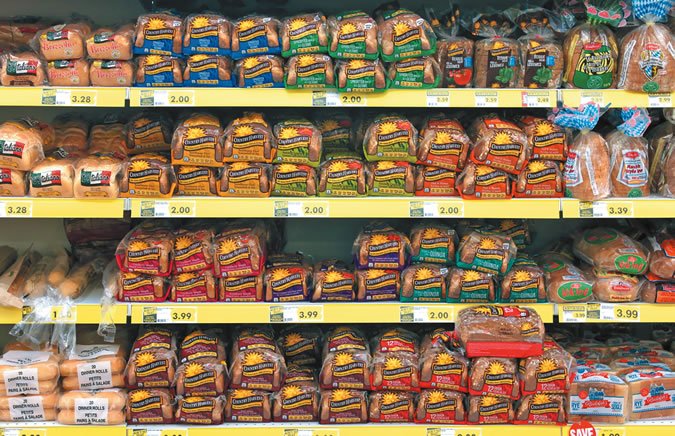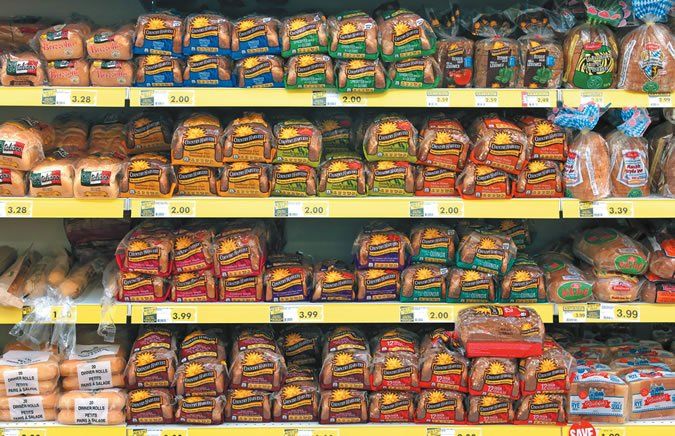
Breads and rolls fill the better part of an aisle in some supermarkets, in part reflecting the appetite of Americans for bread. The 2015-2020 Dietary Guidelines for Americans recommends that at least half of your breads and other grain-based foods, including cereals and energy bars, should be whole grain. But how do you figure out which grains are best for you?
“Making smart choices with regard to the breads offer an opportunity to move toward a healthy dietary pattern,” says Alice H. Lichtenstein, DSc, director of Tufts’ HNRCA Cardiovascular Nutrition Laboratory and executive editor of Tufts Health & Nutrition Letter. “Whole-grain breads you find in supermarkets differ by the relative amount of whole grain content, the type of grain, the sodium content and the amount of added sugars. By perusing ingredient and nutrition labels you can identify some good candidates within different categories, like bread and rolls, try some out and then decide which you prefer.”
Why Whole Grain? Whole grains comprise the entire grain seed: the bran (outer layer, containing fiber, antioxidants and B vitamins), endosperm (middle layer, consisting primarily of starchy carbohydrates), and germ (inner core, containing B vitamins, minerals and some protein). Even if a whole grain has been ground, cracked or flaked, it contains all the original parts of the grain and its naturally occurring nutrients.
In contrast, refined grains are milled and sorted to mostly retain just the endosperm of the original seed. Refined grains generally contain less fiber and fewer nutrients than whole grains, although federal regulations require certain nutrients, like B vitamins, to be added back into the refined grains as well as rice and cornmeal.
Diets rich in whole grains are associated with a variety of health benefits. The fiber in whole grains cause the body to digest more slowly, leading to feelings of prolonged fullness and a more even rises in blood sugar. (Fat-containing foods such as nuts and nut butters, vegetable oils and protein rich foods blunt the glucose spikes as well.)
How to Choose Better Breads: Shopping for whole-grain breads is straightforward but does initially require a bit of time for on-the-spot research in the bread aisle. Here are some practical suggestions:
- Identify whole-grain breads: “Usually you can’t figure that out from the Nutrition Facts label,” Lichtenstein says. “You have to look at the ingredients label. The first ingredient of a whole-grain bread should be whole grain.”
The marketing claims on bread—what the front-of-package label says the product contains—can also be misleading. “Multigrain” or “seven grain,” for example, means the bread contains more than one type of grain, but they’re not necessarily all whole grains. It could be a mix of whole and refined grains. “Made with whole grains” may also indicate the product contains some, but not entirely, whole grains.
Looks can be misleading, too. A bread’s dark brown color could be nothing more than food coloring. “Darker bread does not equal whole grain,” Lichtenstein notes.
Here are additional tips to aid your detective work:
- In the ingredients list, look for “whole wheat” or “whole grain” or just the word “whole” in front of a type of grain or grain flour.
- If you see “100% whole grain/wheat,” that’s a good sign, but if it only says whole grain it may not be 100% whole grain. Manufacturers are permitted to market bread as “whole grain” when only 51% or more of the flour is whole grain.
- Check sodium levels:Breadsand rolls—including whole-grain versions—could contain a significant amount of sodium. High sodium intake is associated with greater risk of high blood pressure; studies have shown diets low in sodium reduce elevated blood pressure. “Go to the Nutrition Facts label and just line up a couple ofbreadsright there on the supermarket shelf and compare the levels of sodium,” Lichtenstein suggests. “Make sure the serving sizes are reasonablyequivalent,and aim for the product with the lowest level.”
- Check added sugars:Bread and rolls can contribute a significant amount of sugar to the diet. As new Nutrient Facts labels are phased in, it will be easier to compare the relative amounts of added sugar among different breads. For now, you will have to rely on the ingredient list and gut feeling: if it tastes sweet, it is probably high in added sugar.
- Try a few:Just because a bread is wholegrain doesn’t mean the smell, tasteandtexture of the product will appeal to you. “Chooseoneyou think you may like the most, try it, and if you don’t like it, try another one,” Lichtenstein says.
Given the number of products on the shelves, you will find a whole-grain bread, or maybe a whole variety of whole-grain breads that you like.
Use the 10 to 1 rule to identify healthier breads:
-Using the Nutrition Facts label, identify the grams of total carbohydrate and fiber per serving.
-Divide the total carbs by 10. Is there at least that much fiber per serving? If so, the food meets to 10:1 standard for healthy grain-based foods.
-For example, consider a whole-grain roll with 25 carbs per serving. Divide by 10: that equals 2.5. If the roll has at least 2.5 grams of fiber per serving, then it meets the 10:1 rule.
























